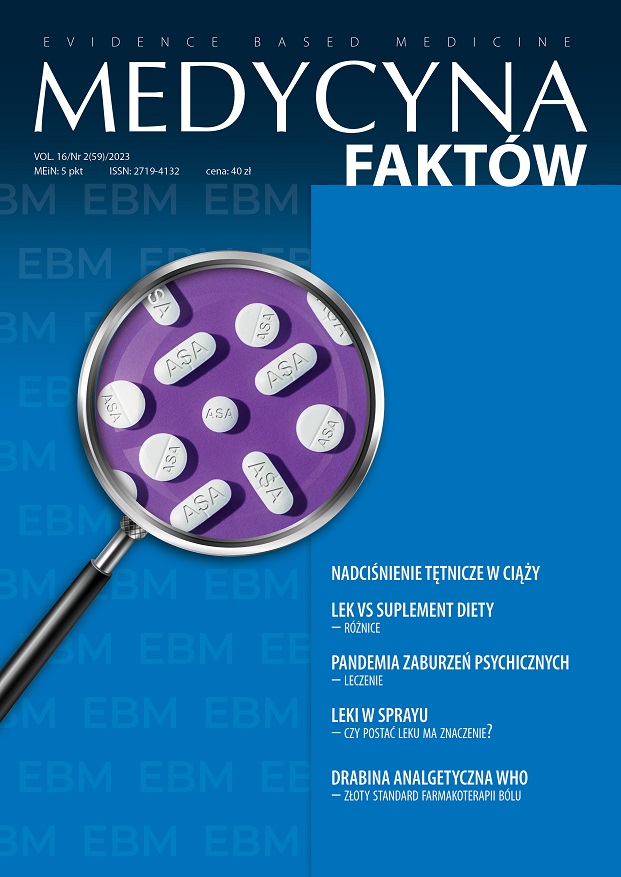The use of antacids and H2 receptor inhibitors in the management of patients with gastroesophageal reflux disease Review article
Main Article Content
Abstract
Patients with gastroesophageal reflux disease may present with a wide range of symptoms caused by various pathophysiological mechanisms.
They are seen as possible causes of treatment resistance and ways of optimizing therapy by adding other drugs, indicated in given symptoms, are sought. In addition to the widely used proton pump inhibitors, we have other groups of drugs at our disposal, including H2 receptor inhibitors and antacids.
Article Details
How to Cite
Mokrowiecka, A. (2023). The use of antacids and H2 receptor inhibitors in the management of patients with gastroesophageal reflux disease. Medycyna Faktow (J EBM), 16(2(59), 214-217. https://doi.org/10.24292/01.MF.0223.13
Issue
Section
Articles
Copyright © by Medical Education. All rights reserved.
References
1. Boeckstaens G, El-Serag HB, Smout AJPM et al. Gut. 2014; 63: 1185-93. http://doi.org/10.1136/gutjnl-2013-306393.
2. Koop H. Medical Therapy of Gastroesophageal Reflux Disease Beyond Proton Pump Inhibitors: Where Are We Heading? Visc Med. 2018; 34(2): 110-5.
3. Smoliński P. Optymalizowanie leczenia uporczywych objawów GERD z uwzględnieniem tzw. terapii dodanej. Lekarz POZ. 2021; 4: 287-93.
4. Gąsiorowska A, Janiak M, Waśko-Czopnik D et al. Postępowanie u pacjentów z objawami choroby refluksowej przełyku – rekomendacje dla lekarzy rodzinnych. Lekarz POZ. 2019; 3-4: 245-65.
5. Lipiński M. Czy obecne podejście do terapii choroby refluksowej przełyku można zoptymalizować? Gastroenterol Prakt. 2020; 3: 50-6.
6. Banks M. The modern investigation and management of gastro-oesophageal reflux disease (GORD). Clin Med. 2009; 6(9): 600-4.
7. Dąbrowski A. Nowości w dziedzinie hamowania wydzielania kwasu solnego w żołądku. Gastroenterol Klin. 2014; 2014; 6(4): 127-33.
8. Postępowanie diagnostyczno-terapeutyczne w chorobie refluksowej przełyku. Konsensus Polskiego Towarzystwa Gastroenterologii 2022. Medycyna Praktyczna 2022; 6: 38-74.
9. Zhai Q, Fu J, Huang X et al. Clinical Study on the Influence of a Fixed-dose Combination of Famotidine with Calcium Carbonate and Magnesium Hydroxide on the Bioavailability of Famotidine. Arzneimittel-Forschung (Drug Research). 2008; 58(11): 581-4.
2. Koop H. Medical Therapy of Gastroesophageal Reflux Disease Beyond Proton Pump Inhibitors: Where Are We Heading? Visc Med. 2018; 34(2): 110-5.
3. Smoliński P. Optymalizowanie leczenia uporczywych objawów GERD z uwzględnieniem tzw. terapii dodanej. Lekarz POZ. 2021; 4: 287-93.
4. Gąsiorowska A, Janiak M, Waśko-Czopnik D et al. Postępowanie u pacjentów z objawami choroby refluksowej przełyku – rekomendacje dla lekarzy rodzinnych. Lekarz POZ. 2019; 3-4: 245-65.
5. Lipiński M. Czy obecne podejście do terapii choroby refluksowej przełyku można zoptymalizować? Gastroenterol Prakt. 2020; 3: 50-6.
6. Banks M. The modern investigation and management of gastro-oesophageal reflux disease (GORD). Clin Med. 2009; 6(9): 600-4.
7. Dąbrowski A. Nowości w dziedzinie hamowania wydzielania kwasu solnego w żołądku. Gastroenterol Klin. 2014; 2014; 6(4): 127-33.
8. Postępowanie diagnostyczno-terapeutyczne w chorobie refluksowej przełyku. Konsensus Polskiego Towarzystwa Gastroenterologii 2022. Medycyna Praktyczna 2022; 6: 38-74.
9. Zhai Q, Fu J, Huang X et al. Clinical Study on the Influence of a Fixed-dose Combination of Famotidine with Calcium Carbonate and Magnesium Hydroxide on the Bioavailability of Famotidine. Arzneimittel-Forschung (Drug Research). 2008; 58(11): 581-4.

